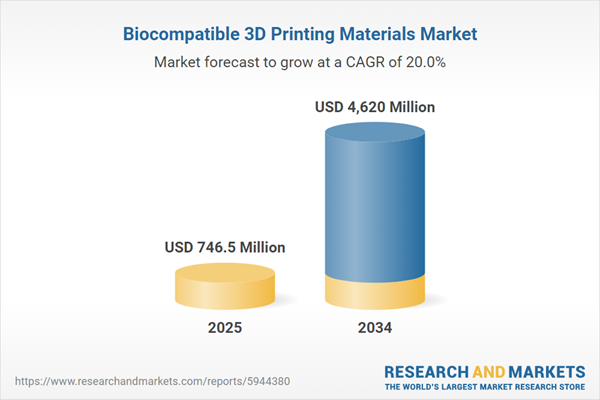The rising preference for additive manufacturing is one of the major factors driving the growth of the biocompatible 3D printing materials industry. The increasing demand for silicone in additive manufacturing owing to its sustainable and biocompatible nature is expected to provide a further boost to the industry as it offers flexibility in product design.
Market Segmentation
The biocompatible 3D printing materials industry can be divided into segments like type, application, and form.Based on its application, the market can be segmented into:
- Implants and Prosthesis
- Prototyping and Surgical Guides
- Tissue Engineering
- Hearing Aid
- Others
Based on its form, the market can be divided into:
- Powder
- Liquid
- Others
Based on its type, the market can be categorised as:
- Polymer
- Metal
- Others
The regional markets for biocompatible 3D printing materials like:
- North America
- Europe
- Asia-Pacific
- Latin America
- Middle East and Africa
Market Analysis
The growing demand for additive manufacturing is one of the key factors contributing to the development of the biocompatible 3D printing materials industry. The demand for additive manufacturing is growing as it is used to produce complex components in the healthcare industry due to its flexible nature.The powder is the leading segment in the global market for biocompatible 3D printing materials. The powder form is compatible with many 3D printers and is therefore used in medical applications such as implants and prostheses, tissue engineering, and surgical tools. Silicone is becoming increasingly popular as a raw material for the additive manufacturing of medical products owing to its chemical resistant properties and flexibility. The use of biocompatible 3D materials also reduces assembly time and wastage of material; thus, minimising production cost of components. This, coupled with the increased investment in the R&D sector to invent other advanced biocompatible 3D printing materials, is expected to impact the market positively during the forecast period.
Competitive Landscape
The report presents a detailed analysis of the following key players in the global biocompatible 3D printing materials industry, looking into their capacity, competitive landscape, and latest developments like capacity expansions, plant turnarounds, and mergers and acquisitions:- 3D Systems, Inc. (NYSE: DDD)
- Evonik Industries AG
- Stratasys Ltd.
- General Electric Company (Concept Laser GmbH)
- Renishaw
- Aspect Biosystems Ltd.
- Detax Ettlingen
- Others
Table of Contents
Companies Mentioned
The key companies featured in this Biocompatible 3D Printing Materials market report include:- 3D Systems Inc.
- Evonik Industries AG
- Stratasys Ltd.
- General Electric Company (Concept Laser GmbH)
- Renishaw Plc
- Aspect Biosystems Ltd.
- Detax Ettlingen
Table Information
| Report Attribute | Details |
|---|---|
| No. of Pages | 176 |
| Published | August 2025 |
| Forecast Period | 2025 - 2034 |
| Estimated Market Value ( USD | $ 746.5 Million |
| Forecasted Market Value ( USD | $ 4620 Million |
| Compound Annual Growth Rate | 20.0% |
| Regions Covered | Global |
| No. of Companies Mentioned | 8 |









